| Construction Rating: | starstarstarstar_borderstar_border |
| Flight Rating: | starstarstarstarstar_border |
| Overall Rating: | starstarstarstarstar_border |
| Diameter: | 4.00 inches |
| Length: | 13.50 inches |
| Manufacturer: | Quest  |
| Skill Level: | 3 |
| Style: | Futuristic/Exotic |
 Brief:
Brief:
An OOP rocket of the Space Clipper from Quest. A scale rocket, it has no fins and is a lifting body. Stability is achieved by placing a ton of mass up in the nose cone. Recovers via two parachutes.
Construction:
Parts list:
- Motor clip
- Blue thrust ring
- Yellow motor mount tube
- 2 Centering rings
- Black die cut parts sheet
- 8.5-inch black body tube
- black plastic nose cone
- 8.5-inch black launch lug
- Black landing gear tube 4
- Clay block
- 8 inch double faced tape strip
- Printed aeroshroud sheet
- 2 Strips of 6 gripper tabs
- 2 12-inch parachutes
- 18-inch elastic shock cord
- 18-inch Kevlar® shock cord
- 2 3/16-inch shroud lines
- Decal sheet
- Instruction sheet
- Scale data sheet
Tools needed:
- White glue
- Sandpaper
- Pencil
- Hobby knife
- Masking tape
The Space Clipper has sat at the bottom of a build pile for years. I got it in part of a hobby shop clearance, and the bag was torn and tatty. When I opened the bag I discovered that two pieces were missing: a black landing gear tube and one of the circular disks from the die cut parts sheet. Neither were a big problem. The landing gear tube was remade from piece of dowel and sprayed black.
The motor mount builds in the normal Quest fashion and uses the Kevlar® and elastic shock cord system. I swapped out the tubular elastic shock cord for a much longer length of elastic cord--this was because I intend to have the clipper recover under one parachute and not in the intended two separate halves.
The rest of the build is non-standard.
The bottom plate of the clipper is glued to the body tube. This proved to be more difficult than I thought, as the sheet had a curve to it that prevented it from laying flat. This curve was removed by ironing it out.
Next, the four frame struts are added. These pieces are made from very thin card, and I would have liked to see them made out of a more rigid material.
Paper tubes that act as the landing gear are then glued into the framework. With advice from folks on TRF, I changed these tube to dowel to improve strength. Then four cross struts are added to give the frame some strength. Feet are then glued to the landing gear tubes. These feet are made from cut outs of the frame.
The paper shroud is than added over the frame work. This was easier than I thought it might have been.
Finishing:
Decals are provided, but I left them off.
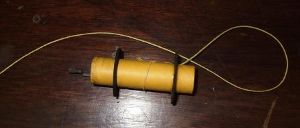

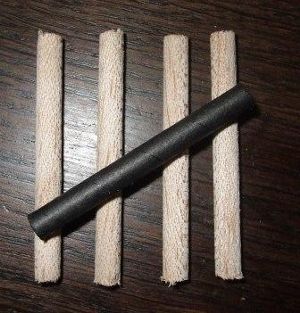


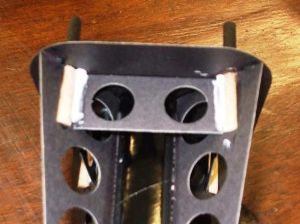
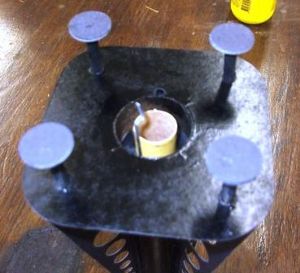
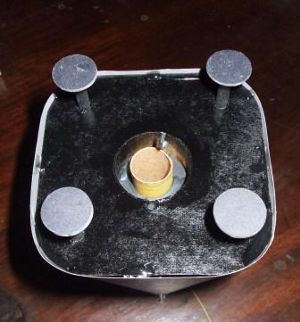


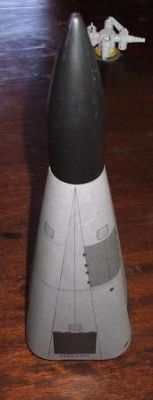
Construction Rating: 3 out of 5
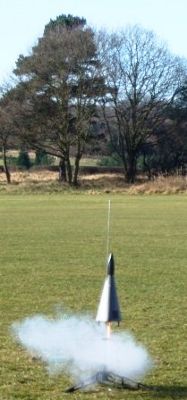
Flight:
Given the mass of the rocket, I stuck to C motors with a short delay (3 seconds).
There is plenty of room in the BT for a 18-inch chute. I used some Nomex® cloth and normal Estes type wadding.
The boost is straight and gets to a decent altitude. My ejection was more like a 2 second delay and she deployed near apogee.
With an 18-inch chute she recovered fine, although she did snap a leg on landing, which was an easy repair.
The second flight gave another straight boost and she recovered without damage.
Third flight gave a slight arc into the wind. Ejection was after apogee and she recovered hard, snapping another--and different--leg. Another easy repair.

Recovery:
I would not like to fly her on two separate chutes, especially the quest type.
Flight Rating: 4 out of 5
Overall Rating: 4 out of 5
Other Reviews
- Quest DC-Y Space Clipper By Hans "Chris" Michielssen (June 13, 2009)
I won this on eBay for $10.00. This is the entire, unopened Quest starter kit with launcher, launch controller, kit and 3 C6-3 engines. It was packaged in the mid-1990s. I didn't expect the engines to be included, but they were sent. I'd always liked the simplicity of the Quest PVC Tripod launcher. The older hand-held controller was very comfortable and ergonomic. I might use this for my ...
- Quest DC-Y Space Clipper By Jim Moncher
Brief Paper shroud construction and dual chute recovery. Construction This was the first Quest kit I have built and was pleased with almost all aspects. The kit came in the common bag; no parts were missing or broken. This kit is a finless, Skill Level 3 features paper shroud construction and dual 12-inch parachute recovery. More on the 'chutes later. The instructions were easy to follow ...
 |
 |
Flights
Sponsored Ads
 |
 |











